BMP3005 Applied Business Finance: Importance of Financial Management
VerifiedAdded on 2023/06/14
|15
|2660
|309
Report
AI Summary
This report provides a comprehensive overview of financial management, emphasizing its importance in organizational success. It delves into key concepts such as financing, investing, and dividend decisions, highlighting how effective fund management enables businesses to invest in profitable projects, understand fund flows, and develop future strategies. The report also examines the main financial statements—income statement, balance sheet, and cash flow statement—and their role in assessing financial health. Furthermore, it explains the use of financial ratios, including liquidity, leverage, turnover, and profitability ratios, in evaluating a company's financial condition. A business review is presented, showcasing the company's performance and areas for improvement. Finally, the report suggests strategies for businesses to enhance their performance, such as cutting expenses, improving marketing tactics, using retained earnings, and consistently monitoring financial statements. Desklib offers a wealth of similar resources for students seeking to deepen their understanding of financial management.
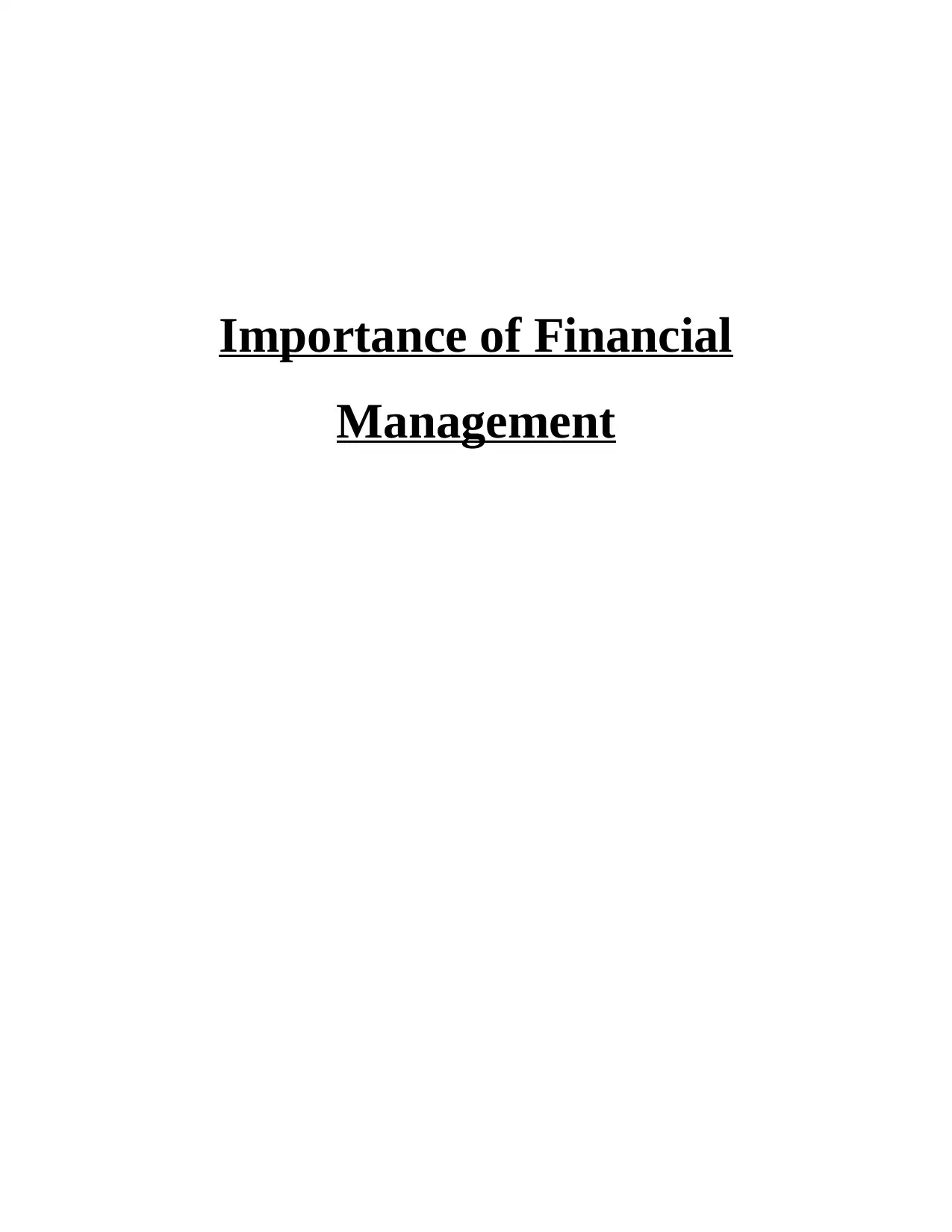
Importance of Financial
Management
Management
Paraphrase This Document
Need a fresh take? Get an instant paraphrase of this document with our AI Paraphraser

Table of Contents
Introduction......................................................................................................................................3
Section 1...........................................................................................................................................3
Concept of Financial Management :...........................................................................................3
Fund management is important due to various reasons such as :...............................................4
Section 2...........................................................................................................................................5
Main financial statements of the organisation : .........................................................................5
Use of financial ratios in financial management :.......................................................................6
Section 3...........................................................................................................................................7
Business Review : ......................................................................................................................7
Income Statement : .....................................................................................................................7
Balance Sheet : ...........................................................................................................................7
Section 4...........................................................................................................................................8
This explains how businesses can improve their performance:..................................................8
Conclusion:......................................................................................................................................9
Reference :.......................................................................................................................................9
Appendix:.......................................................................................................................................11
Introduction......................................................................................................................................3
Section 1...........................................................................................................................................3
Concept of Financial Management :...........................................................................................3
Fund management is important due to various reasons such as :...............................................4
Section 2...........................................................................................................................................5
Main financial statements of the organisation : .........................................................................5
Use of financial ratios in financial management :.......................................................................6
Section 3...........................................................................................................................................7
Business Review : ......................................................................................................................7
Income Statement : .....................................................................................................................7
Balance Sheet : ...........................................................................................................................7
Section 4...........................................................................................................................................8
This explains how businesses can improve their performance:..................................................8
Conclusion:......................................................................................................................................9
Reference :.......................................................................................................................................9
Appendix:.......................................................................................................................................11

Introduction
This report focuses on the concept and importance of fund management in the
organisation. Management of finance properly will allow businesses to conduct the operations
smoothly and improve the performance on consistent basis. In addition to this, in financial
management managers take all important decisions with regards to raising of funds from various
sources and investing in profitable projects. Other than this, following report highlights the use
of income statements and balance sheet in order to enhance the performance of business concern.
In this, ratios are also calculated to ascertain the financial condition of the organisation.
Section 1
Concept of Financial Management :
Fund management is all about taking all the crucial decisions with regards to funds of
business. Funds are lifeline of any organisation without which it cannot carry out its operations.
So, as per this, financial manager has to take all important decisions of financing, investing and
distributing of funds. There are various decisions taken with respect to funds such as :(Barr and
McClellan, 2018)
Financing decision : it is concerned with how much funds is to be raised form long term
sources such as equity shares, preference shares, debentures, borrowings from banks and
other financial institutions and so on. It is also known as decision of capital structure.
[ Capital structure = Owner's fund + Borrowed funds ]
Along with this decision there comes the risk of its repayment of capital and periodical interest.
So, finance managers has to take all important decisions after considering all internal and
external factors.
Investing decision : it is concerned with how companies make decision with regards to
investing in short term or long term projects. Long term decision is considered as capital
budgeting which involves huge investment of funds for long term purposes whereas,
short term decisions are known as working capital decisions which requires competitively
lesser amount of funds for operating businesses.
This report focuses on the concept and importance of fund management in the
organisation. Management of finance properly will allow businesses to conduct the operations
smoothly and improve the performance on consistent basis. In addition to this, in financial
management managers take all important decisions with regards to raising of funds from various
sources and investing in profitable projects. Other than this, following report highlights the use
of income statements and balance sheet in order to enhance the performance of business concern.
In this, ratios are also calculated to ascertain the financial condition of the organisation.
Section 1
Concept of Financial Management :
Fund management is all about taking all the crucial decisions with regards to funds of
business. Funds are lifeline of any organisation without which it cannot carry out its operations.
So, as per this, financial manager has to take all important decisions of financing, investing and
distributing of funds. There are various decisions taken with respect to funds such as :(Barr and
McClellan, 2018)
Financing decision : it is concerned with how much funds is to be raised form long term
sources such as equity shares, preference shares, debentures, borrowings from banks and
other financial institutions and so on. It is also known as decision of capital structure.
[ Capital structure = Owner's fund + Borrowed funds ]
Along with this decision there comes the risk of its repayment of capital and periodical interest.
So, finance managers has to take all important decisions after considering all internal and
external factors.
Investing decision : it is concerned with how companies make decision with regards to
investing in short term or long term projects. Long term decision is considered as capital
budgeting which involves huge investment of funds for long term purposes whereas,
short term decisions are known as working capital decisions which requires competitively
lesser amount of funds for operating businesses.
⊘ This is a preview!⊘
Do you want full access?
Subscribe today to unlock all pages.

Trusted by 1+ million students worldwide
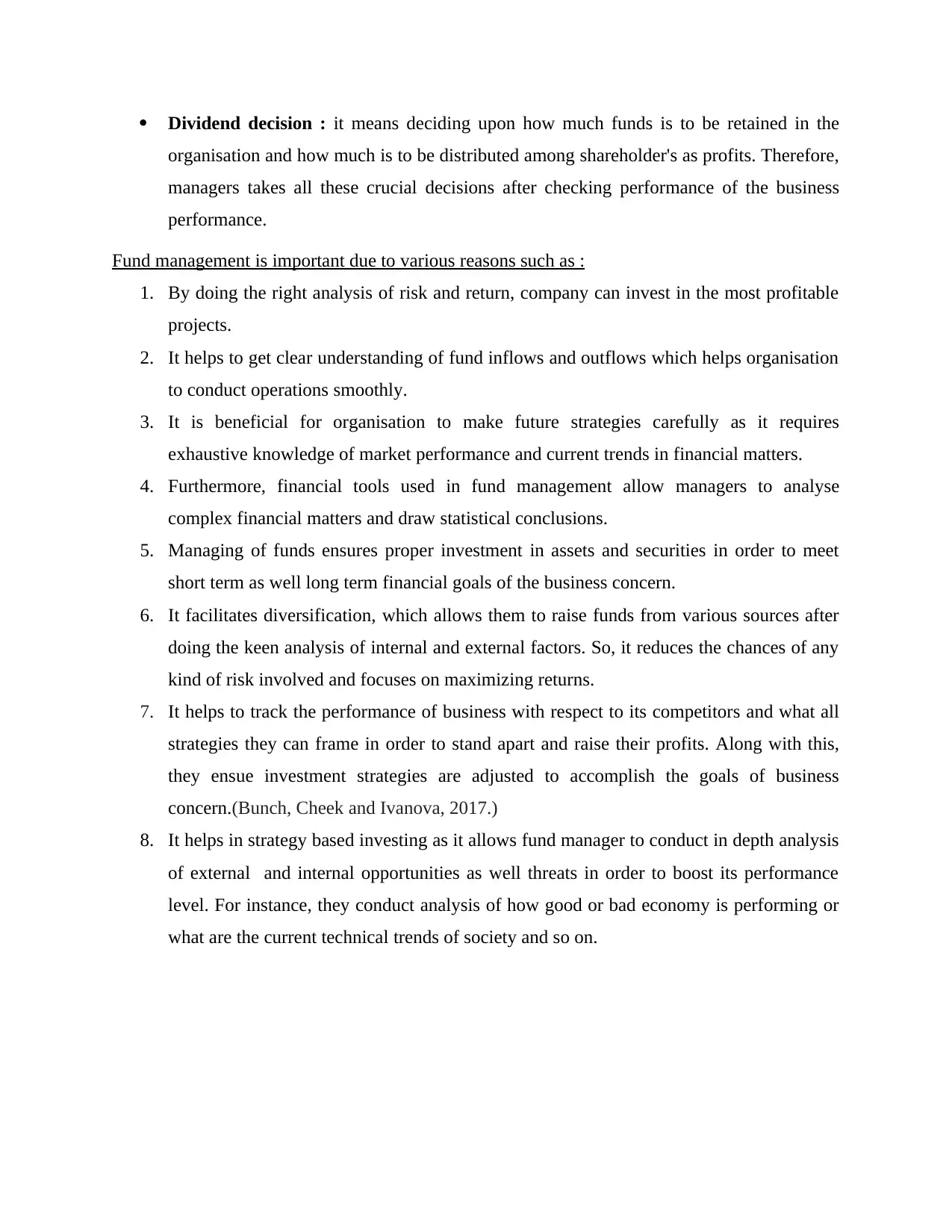
Dividend decision : it means deciding upon how much funds is to be retained in the
organisation and how much is to be distributed among shareholder's as profits. Therefore,
managers takes all these crucial decisions after checking performance of the business
performance.
Fund management is important due to various reasons such as :
1. By doing the right analysis of risk and return, company can invest in the most profitable
projects.
2. It helps to get clear understanding of fund inflows and outflows which helps organisation
to conduct operations smoothly.
3. It is beneficial for organisation to make future strategies carefully as it requires
exhaustive knowledge of market performance and current trends in financial matters.
4. Furthermore, financial tools used in fund management allow managers to analyse
complex financial matters and draw statistical conclusions.
5. Managing of funds ensures proper investment in assets and securities in order to meet
short term as well long term financial goals of the business concern.
6. It facilitates diversification, which allows them to raise funds from various sources after
doing the keen analysis of internal and external factors. So, it reduces the chances of any
kind of risk involved and focuses on maximizing returns.
7. It helps to track the performance of business with respect to its competitors and what all
strategies they can frame in order to stand apart and raise their profits. Along with this,
they ensue investment strategies are adjusted to accomplish the goals of business
concern.(Bunch, Cheek and Ivanova, 2017.)
8. It helps in strategy based investing as it allows fund manager to conduct in depth analysis
of external and internal opportunities as well threats in order to boost its performance
level. For instance, they conduct analysis of how good or bad economy is performing or
what are the current technical trends of society and so on.
organisation and how much is to be distributed among shareholder's as profits. Therefore,
managers takes all these crucial decisions after checking performance of the business
performance.
Fund management is important due to various reasons such as :
1. By doing the right analysis of risk and return, company can invest in the most profitable
projects.
2. It helps to get clear understanding of fund inflows and outflows which helps organisation
to conduct operations smoothly.
3. It is beneficial for organisation to make future strategies carefully as it requires
exhaustive knowledge of market performance and current trends in financial matters.
4. Furthermore, financial tools used in fund management allow managers to analyse
complex financial matters and draw statistical conclusions.
5. Managing of funds ensures proper investment in assets and securities in order to meet
short term as well long term financial goals of the business concern.
6. It facilitates diversification, which allows them to raise funds from various sources after
doing the keen analysis of internal and external factors. So, it reduces the chances of any
kind of risk involved and focuses on maximizing returns.
7. It helps to track the performance of business with respect to its competitors and what all
strategies they can frame in order to stand apart and raise their profits. Along with this,
they ensue investment strategies are adjusted to accomplish the goals of business
concern.(Bunch, Cheek and Ivanova, 2017.)
8. It helps in strategy based investing as it allows fund manager to conduct in depth analysis
of external and internal opportunities as well threats in order to boost its performance
level. For instance, they conduct analysis of how good or bad economy is performing or
what are the current technical trends of society and so on.
Paraphrase This Document
Need a fresh take? Get an instant paraphrase of this document with our AI Paraphraser

Section 2
Main financial statements of the organisation :
Financial statements : these are the summary record of all monetary transactions incurred
in business. It showcases financial health of the business which is used by internal and external
users for the purpose of decision making. Besides this, it highlights all the weak areas for
improvement purposes. Main financial statements of business are income statement, balance
sheet, cash flow statement, changes in equity and others. These statements are prepared with
principles and conventions of accounting.
Income statement : It showcases company's expenses and incomes within a specific period of
time. It is calculated after deducting all operating and non operating expenses form revenues
earned by organisation. Besides this, it has many other benefits such as balancing off the capital
account at the year end. It helps to determine whether company is making profit or loss over
specific period of time. It clearly states what all cost has been incurred in conducting the
operations and where they can put control over their cost. It provide information about
company's financial condition with respect to its competitors.(Drew, 2018)
Balance sheet : It is a summary statement which shows company's assets, liabilities and equity
which represents company's current financial condition. It helps to calculate useful ratios of
organisation which shows current value and position of all assets and liabilities. This statement is
prepared by presenting equity and liabilities in one section and assets on the other. This is a
snapshot of company which depicts company's financial condition at a specific point of time.
Cash flow statement : It shows cash inflows and outflows due to changes in expenses and
incomes of the organisation. It is categorized in three main activities namely operating, investing
and financing. It records all cash inflows and outflows to determine the short term payment
ability of businesses. Moreover, it is used as a financial tool which helps to evaluate changes in
net assets of an organisation as well as cash generating capacity. Besides this, it helps
management and users to make better economic and financial decisions.
Main financial statements of the organisation :
Financial statements : these are the summary record of all monetary transactions incurred
in business. It showcases financial health of the business which is used by internal and external
users for the purpose of decision making. Besides this, it highlights all the weak areas for
improvement purposes. Main financial statements of business are income statement, balance
sheet, cash flow statement, changes in equity and others. These statements are prepared with
principles and conventions of accounting.
Income statement : It showcases company's expenses and incomes within a specific period of
time. It is calculated after deducting all operating and non operating expenses form revenues
earned by organisation. Besides this, it has many other benefits such as balancing off the capital
account at the year end. It helps to determine whether company is making profit or loss over
specific period of time. It clearly states what all cost has been incurred in conducting the
operations and where they can put control over their cost. It provide information about
company's financial condition with respect to its competitors.(Drew, 2018)
Balance sheet : It is a summary statement which shows company's assets, liabilities and equity
which represents company's current financial condition. It helps to calculate useful ratios of
organisation which shows current value and position of all assets and liabilities. This statement is
prepared by presenting equity and liabilities in one section and assets on the other. This is a
snapshot of company which depicts company's financial condition at a specific point of time.
Cash flow statement : It shows cash inflows and outflows due to changes in expenses and
incomes of the organisation. It is categorized in three main activities namely operating, investing
and financing. It records all cash inflows and outflows to determine the short term payment
ability of businesses. Moreover, it is used as a financial tool which helps to evaluate changes in
net assets of an organisation as well as cash generating capacity. Besides this, it helps
management and users to make better economic and financial decisions.

Use of financial ratios in financial management :
Ratios shows relationships between two components which showcases company's actual
financial condition. These are used to evaluate overall financial health of the enterprise.
Moreover, these helps internal and external users to take all crucial decision with regards to
raising of funds, investment of funds and its distribution. Various ratios which are calculated are
as follows,
Liquidity ratios : These ratios are calculated to check upon whether the company would
be able to make short term payments on time or not. It is used to check on time payment
making capability of business concern. This include ratios such as current ratio, quick
ratio, cash ratio and so on. So to check short term solvency position of business concern
these ratios are calculated.
Leverage ratios : These are used to check the long term payment making ability of the
concern. It includes debt equity ratio, capital gearing ratio and others. So, a firm should
adopt strategy that minimizes risk and maximizes returns of the organisation.
Turnover ratios : These ratios are used to check effectiveness and efficiency of the
business concern with the objective of checking its performance. This includes various
ratios such as inventory turnover ratio, debtor turnover ratio, creditor turnover ratio and
others. These are used to evaluate performance of business concern in order to make
future profits.(Merawati, and Kumalasari, 2020)
Profitability ratios : It helps to ascertain the profits/loss of the enterprise. Various ratios
are calculated in order to monitor the performance of business concern such as gross
profit ratio, net profit ratio, operating profit ratio, return on capital employed and so on.
These helps to monitor whether all resources of organisation are used effective utilized or
not in order to boost up the profits of organisation.
Ratios shows relationships between two components which showcases company's actual
financial condition. These are used to evaluate overall financial health of the enterprise.
Moreover, these helps internal and external users to take all crucial decision with regards to
raising of funds, investment of funds and its distribution. Various ratios which are calculated are
as follows,
Liquidity ratios : These ratios are calculated to check upon whether the company would
be able to make short term payments on time or not. It is used to check on time payment
making capability of business concern. This include ratios such as current ratio, quick
ratio, cash ratio and so on. So to check short term solvency position of business concern
these ratios are calculated.
Leverage ratios : These are used to check the long term payment making ability of the
concern. It includes debt equity ratio, capital gearing ratio and others. So, a firm should
adopt strategy that minimizes risk and maximizes returns of the organisation.
Turnover ratios : These ratios are used to check effectiveness and efficiency of the
business concern with the objective of checking its performance. This includes various
ratios such as inventory turnover ratio, debtor turnover ratio, creditor turnover ratio and
others. These are used to evaluate performance of business concern in order to make
future profits.(Merawati, and Kumalasari, 2020)
Profitability ratios : It helps to ascertain the profits/loss of the enterprise. Various ratios
are calculated in order to monitor the performance of business concern such as gross
profit ratio, net profit ratio, operating profit ratio, return on capital employed and so on.
These helps to monitor whether all resources of organisation are used effective utilized or
not in order to boost up the profits of organisation.
⊘ This is a preview!⊘
Do you want full access?
Subscribe today to unlock all pages.

Trusted by 1+ million students worldwide

Section 3
Business Review :
This will showcase complete business performance and which areas needs major focus.
Moreover, this clearly states companies profits after considering all incomes and expenses. In
this ratios are calculated which depicts the liquidity and profitability position of the concern. (see
appendix 1)
Income Statement :
This shows net profit/loss of the organisation. It is calculated by deducting all operating
and non operating expenses from revenues of the concern. (Lipson, 2019)Operating expenses are
the ones which incurs as a result of performing operations whereas, non operating are the ones
which are not related to business operations. ( see appendix 2 )
Balance Sheet :
It is prepared to ascertain true and fair financial condition of business concern. This is
prepared by taking all the assets, liabilities and equity of operations. On assets side all current
and fixed assets are considered which helps to get clear picture of what all resources business
has. And on liabilities side all current and future liabilities are taken to get equal results on both
sides. (see appendix 3)
Calculations of the ratios as per the financial statements:
Gross profit : Revenue – Cost of goods sold
= £(189711 – 108586)
£81125
1. Net profit : Total revenue – Total expenses
= £(189711 – 146655)
£43056
Net profit increased in 2016 by 127% during the year.
Shareholder's equity increased by 32.9% by £54343
Business Review :
This will showcase complete business performance and which areas needs major focus.
Moreover, this clearly states companies profits after considering all incomes and expenses. In
this ratios are calculated which depicts the liquidity and profitability position of the concern. (see
appendix 1)
Income Statement :
This shows net profit/loss of the organisation. It is calculated by deducting all operating
and non operating expenses from revenues of the concern. (Lipson, 2019)Operating expenses are
the ones which incurs as a result of performing operations whereas, non operating are the ones
which are not related to business operations. ( see appendix 2 )
Balance Sheet :
It is prepared to ascertain true and fair financial condition of business concern. This is
prepared by taking all the assets, liabilities and equity of operations. On assets side all current
and fixed assets are considered which helps to get clear picture of what all resources business
has. And on liabilities side all current and future liabilities are taken to get equal results on both
sides. (see appendix 3)
Calculations of the ratios as per the financial statements:
Gross profit : Revenue – Cost of goods sold
= £(189711 – 108586)
£81125
1. Net profit : Total revenue – Total expenses
= £(189711 – 146655)
£43056
Net profit increased in 2016 by 127% during the year.
Shareholder's equity increased by 32.9% by £54343
Paraphrase This Document
Need a fresh take? Get an instant paraphrase of this document with our AI Paraphraser
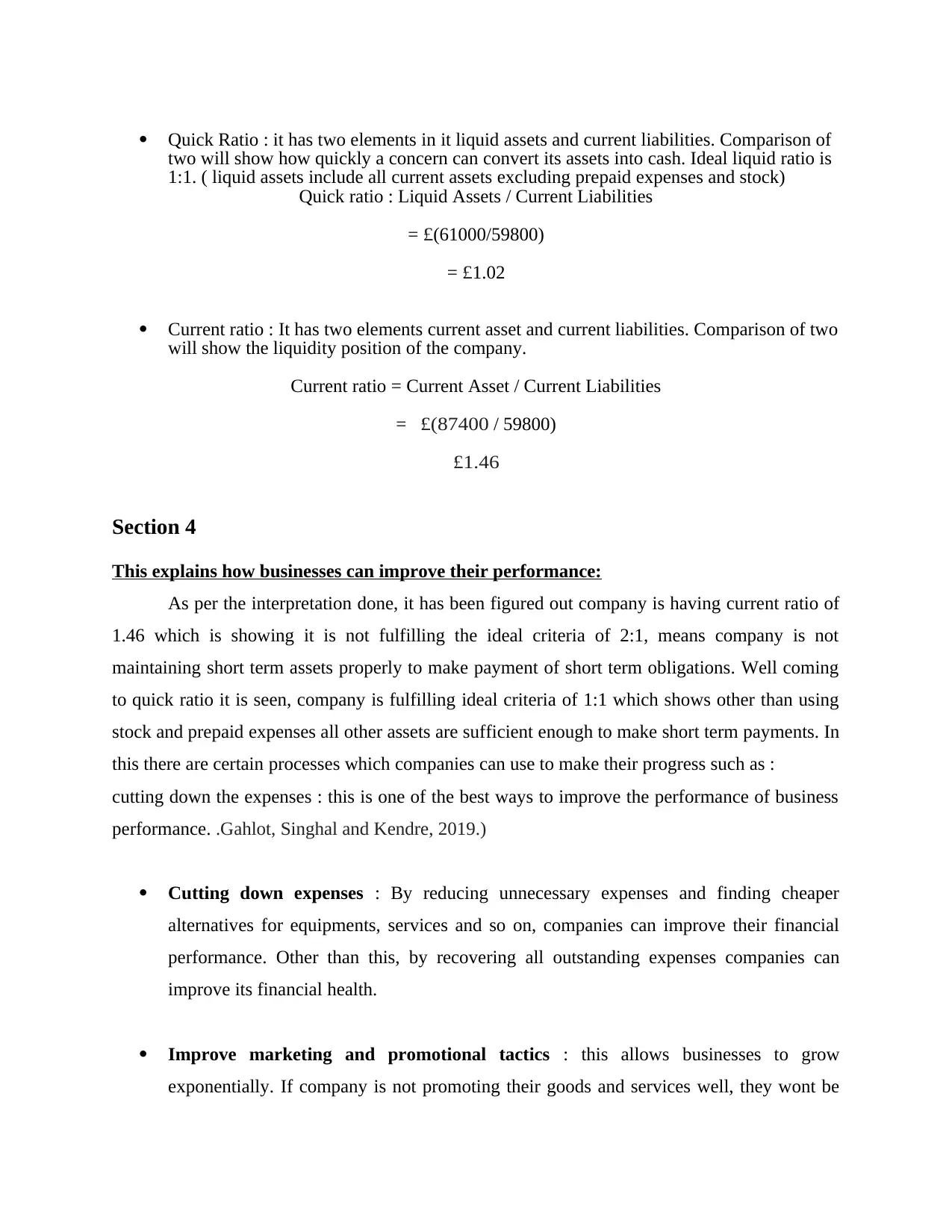
Quick Ratio : it has two elements in it liquid assets and current liabilities. Comparison of
two will show how quickly a concern can convert its assets into cash. Ideal liquid ratio is
1:1. ( liquid assets include all current assets excluding prepaid expenses and stock)
Quick ratio : Liquid Assets / Current Liabilities
= £(61000/59800)
= £1.02
Current ratio : It has two elements current asset and current liabilities. Comparison of two
will show the liquidity position of the company.
Current ratio = Current Asset / Current Liabilities
= £(87400 / 59800)
£1.46
Section 4
This explains how businesses can improve their performance:
As per the interpretation done, it has been figured out company is having current ratio of
1.46 which is showing it is not fulfilling the ideal criteria of 2:1, means company is not
maintaining short term assets properly to make payment of short term obligations. Well coming
to quick ratio it is seen, company is fulfilling ideal criteria of 1:1 which shows other than using
stock and prepaid expenses all other assets are sufficient enough to make short term payments. In
this there are certain processes which companies can use to make their progress such as :
cutting down the expenses : this is one of the best ways to improve the performance of business
performance. .Gahlot, Singhal and Kendre, 2019.)
Cutting down expenses : By reducing unnecessary expenses and finding cheaper
alternatives for equipments, services and so on, companies can improve their financial
performance. Other than this, by recovering all outstanding expenses companies can
improve its financial health.
Improve marketing and promotional tactics : this allows businesses to grow
exponentially. If company is not promoting their goods and services well, they wont be
two will show how quickly a concern can convert its assets into cash. Ideal liquid ratio is
1:1. ( liquid assets include all current assets excluding prepaid expenses and stock)
Quick ratio : Liquid Assets / Current Liabilities
= £(61000/59800)
= £1.02
Current ratio : It has two elements current asset and current liabilities. Comparison of two
will show the liquidity position of the company.
Current ratio = Current Asset / Current Liabilities
= £(87400 / 59800)
£1.46
Section 4
This explains how businesses can improve their performance:
As per the interpretation done, it has been figured out company is having current ratio of
1.46 which is showing it is not fulfilling the ideal criteria of 2:1, means company is not
maintaining short term assets properly to make payment of short term obligations. Well coming
to quick ratio it is seen, company is fulfilling ideal criteria of 1:1 which shows other than using
stock and prepaid expenses all other assets are sufficient enough to make short term payments. In
this there are certain processes which companies can use to make their progress such as :
cutting down the expenses : this is one of the best ways to improve the performance of business
performance. .Gahlot, Singhal and Kendre, 2019.)
Cutting down expenses : By reducing unnecessary expenses and finding cheaper
alternatives for equipments, services and so on, companies can improve their financial
performance. Other than this, by recovering all outstanding expenses companies can
improve its financial health.
Improve marketing and promotional tactics : this allows businesses to grow
exponentially. If company is not promoting their goods and services well, they wont be
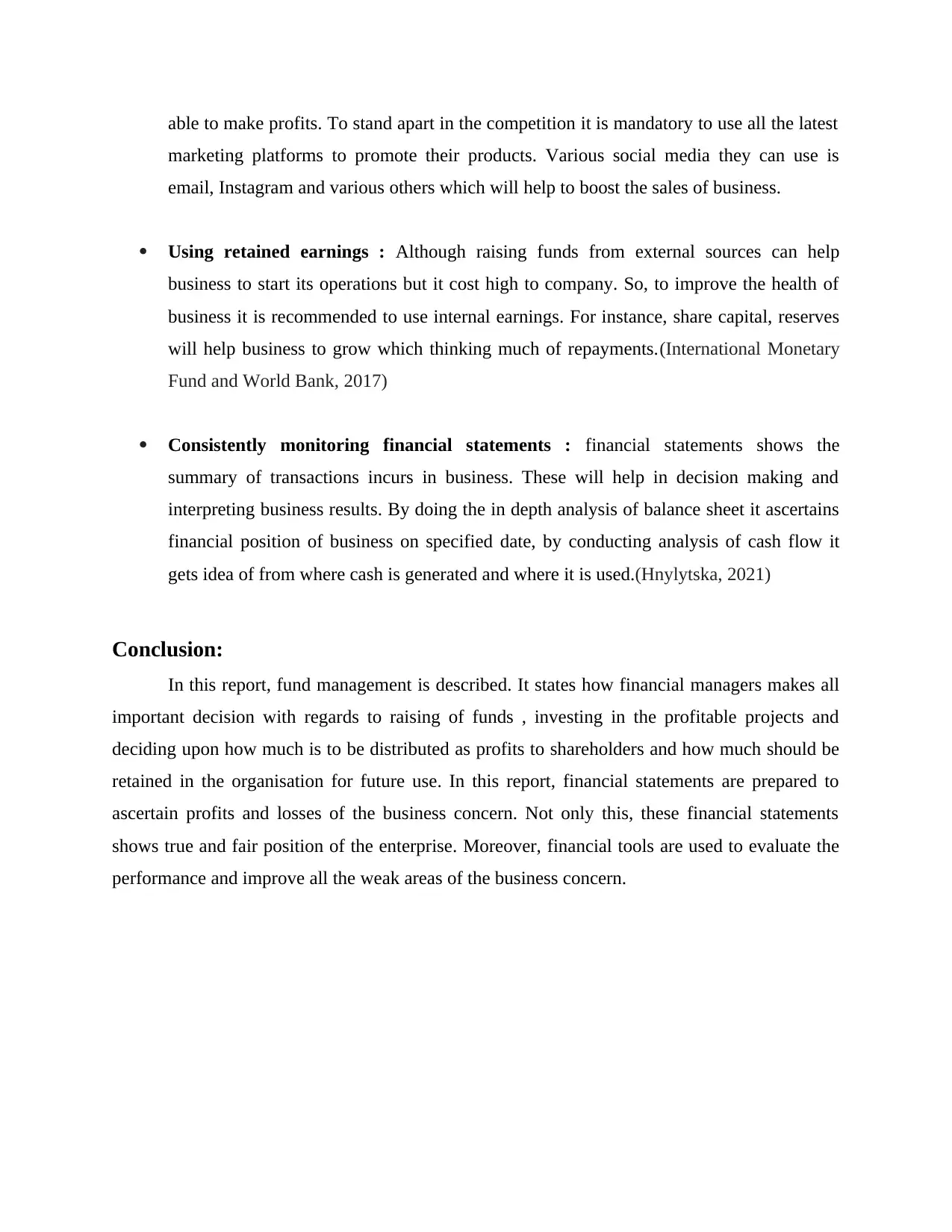
able to make profits. To stand apart in the competition it is mandatory to use all the latest
marketing platforms to promote their products. Various social media they can use is
email, Instagram and various others which will help to boost the sales of business.
Using retained earnings : Although raising funds from external sources can help
business to start its operations but it cost high to company. So, to improve the health of
business it is recommended to use internal earnings. For instance, share capital, reserves
will help business to grow which thinking much of repayments.(International Monetary
Fund and World Bank, 2017)
Consistently monitoring financial statements : financial statements shows the
summary of transactions incurs in business. These will help in decision making and
interpreting business results. By doing the in depth analysis of balance sheet it ascertains
financial position of business on specified date, by conducting analysis of cash flow it
gets idea of from where cash is generated and where it is used.(Hnylytska, 2021)
Conclusion:
In this report, fund management is described. It states how financial managers makes all
important decision with regards to raising of funds , investing in the profitable projects and
deciding upon how much is to be distributed as profits to shareholders and how much should be
retained in the organisation for future use. In this report, financial statements are prepared to
ascertain profits and losses of the business concern. Not only this, these financial statements
shows true and fair position of the enterprise. Moreover, financial tools are used to evaluate the
performance and improve all the weak areas of the business concern.
marketing platforms to promote their products. Various social media they can use is
email, Instagram and various others which will help to boost the sales of business.
Using retained earnings : Although raising funds from external sources can help
business to start its operations but it cost high to company. So, to improve the health of
business it is recommended to use internal earnings. For instance, share capital, reserves
will help business to grow which thinking much of repayments.(International Monetary
Fund and World Bank, 2017)
Consistently monitoring financial statements : financial statements shows the
summary of transactions incurs in business. These will help in decision making and
interpreting business results. By doing the in depth analysis of balance sheet it ascertains
financial position of business on specified date, by conducting analysis of cash flow it
gets idea of from where cash is generated and where it is used.(Hnylytska, 2021)
Conclusion:
In this report, fund management is described. It states how financial managers makes all
important decision with regards to raising of funds , investing in the profitable projects and
deciding upon how much is to be distributed as profits to shareholders and how much should be
retained in the organisation for future use. In this report, financial statements are prepared to
ascertain profits and losses of the business concern. Not only this, these financial statements
shows true and fair position of the enterprise. Moreover, financial tools are used to evaluate the
performance and improve all the weak areas of the business concern.
⊘ This is a preview!⊘
Do you want full access?
Subscribe today to unlock all pages.

Trusted by 1+ million students worldwide
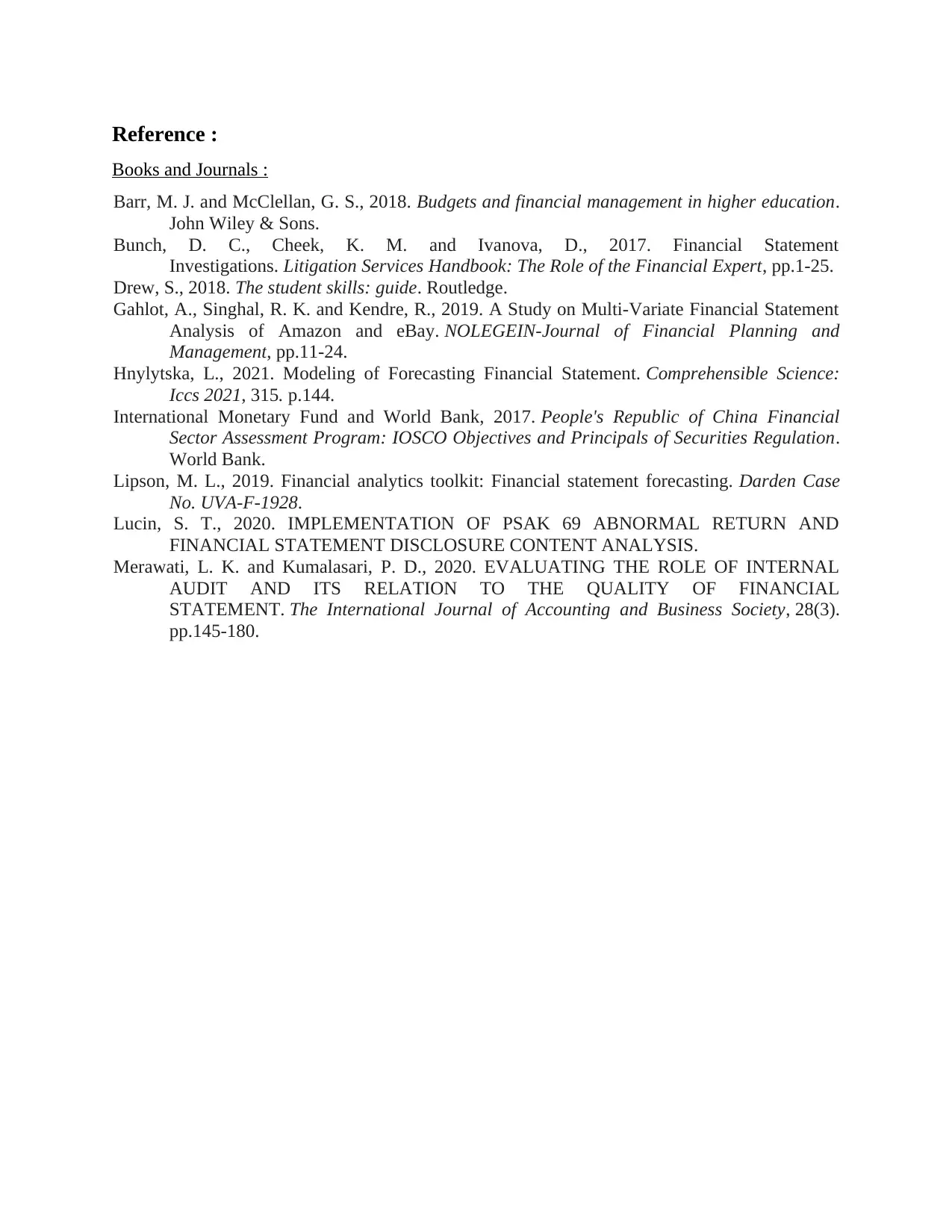
Reference :
Books and Journals :
Barr, M. J. and McClellan, G. S., 2018. Budgets and financial management in higher education.
John Wiley & Sons.
Bunch, D. C., Cheek, K. M. and Ivanova, D., 2017. Financial Statement
Investigations. Litigation Services Handbook: The Role of the Financial Expert, pp.1-25.
Drew, S., 2018. The student skills: guide. Routledge.
Gahlot, A., Singhal, R. K. and Kendre, R., 2019. A Study on Multi-Variate Financial Statement
Analysis of Amazon and eBay. NOLEGEIN-Journal of Financial Planning and
Management, pp.11-24.
Hnylytska, L., 2021. Modeling of Forecasting Financial Statement. Comprehensible Science:
Iccs 2021, 315. p.144.
International Monetary Fund and World Bank, 2017. People's Republic of China Financial
Sector Assessment Program: IOSCO Objectives and Principals of Securities Regulation.
World Bank.
Lipson, M. L., 2019. Financial analytics toolkit: Financial statement forecasting. Darden Case
No. UVA-F-1928.
Lucin, S. T., 2020. IMPLEMENTATION OF PSAK 69 ABNORMAL RETURN AND
FINANCIAL STATEMENT DISCLOSURE CONTENT ANALYSIS.
Merawati, L. K. and Kumalasari, P. D., 2020. EVALUATING THE ROLE OF INTERNAL
AUDIT AND ITS RELATION TO THE QUALITY OF FINANCIAL
STATEMENT. The International Journal of Accounting and Business Society, 28(3).
pp.145-180.
Books and Journals :
Barr, M. J. and McClellan, G. S., 2018. Budgets and financial management in higher education.
John Wiley & Sons.
Bunch, D. C., Cheek, K. M. and Ivanova, D., 2017. Financial Statement
Investigations. Litigation Services Handbook: The Role of the Financial Expert, pp.1-25.
Drew, S., 2018. The student skills: guide. Routledge.
Gahlot, A., Singhal, R. K. and Kendre, R., 2019. A Study on Multi-Variate Financial Statement
Analysis of Amazon and eBay. NOLEGEIN-Journal of Financial Planning and
Management, pp.11-24.
Hnylytska, L., 2021. Modeling of Forecasting Financial Statement. Comprehensible Science:
Iccs 2021, 315. p.144.
International Monetary Fund and World Bank, 2017. People's Republic of China Financial
Sector Assessment Program: IOSCO Objectives and Principals of Securities Regulation.
World Bank.
Lipson, M. L., 2019. Financial analytics toolkit: Financial statement forecasting. Darden Case
No. UVA-F-1928.
Lucin, S. T., 2020. IMPLEMENTATION OF PSAK 69 ABNORMAL RETURN AND
FINANCIAL STATEMENT DISCLOSURE CONTENT ANALYSIS.
Merawati, L. K. and Kumalasari, P. D., 2020. EVALUATING THE ROLE OF INTERNAL
AUDIT AND ITS RELATION TO THE QUALITY OF FINANCIAL
STATEMENT. The International Journal of Accounting and Business Society, 28(3).
pp.145-180.
Paraphrase This Document
Need a fresh take? Get an instant paraphrase of this document with our AI Paraphraser

Appendix:
Appendix 1
Appendix 1

⊘ This is a preview!⊘
Do you want full access?
Subscribe today to unlock all pages.

Trusted by 1+ million students worldwide
1 out of 15
Related Documents
Your All-in-One AI-Powered Toolkit for Academic Success.
+13062052269
info@desklib.com
Available 24*7 on WhatsApp / Email
![[object Object]](/_next/static/media/star-bottom.7253800d.svg)
Unlock your academic potential
Copyright © 2020–2025 A2Z Services. All Rights Reserved. Developed and managed by ZUCOL.

